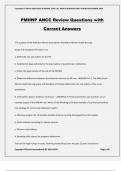Exam (elaborations)
PMHNP ANCC Review Questions with Correct Answers
PMHNP ANCC Review Questions with
Correct Answers
The purpose of the American Nurses Association's Psychiatric-Mental Health Nursing:
Scope and Standards of Practice is to
a. Define the role and actions for the NP
b. Establish the legal authority for the prescription of psychotropic medications...
[Show more]
Preview 4 out of 45 pages
Uploaded on
November 3, 2024
Number of pages
45
Written in
2024/2025
Type
Exam (elaborations)
Contains
Questions & answers
Institution
Ancc
Course
Ancc
$13.49
Also available in package deal from $56.99
100% satisfaction guarantee
Immediately available after payment
Both online and in PDF
No strings attached
Also available in package deal (1)
1. Exam (elaborations) - Ancc adult gerontology acute care study guide solutions
2. Exam (elaborations) - Ancc aprn exam questions with correct answers
3. Exam (elaborations) - Ancc exam study guide solutions
4. Exam (elaborations) - Sample questions from ancc exam with correct answers
5. Exam (elaborations) - Ancc fnp board questions with correct answers
6. Exam (elaborations) - Ancc med-surg certification exam questions and answers 100% pass
7. Exam (elaborations) - Ancc nurse executive general questions i with correct answers
8. Exam (elaborations) - Ancc practice questions with correct answers 100% pass
9. Exam (elaborations) - Pmhnp ancc review questions with correct answers
Show more
Copyright © KAYLIN 2024/2025 ACADEMIC YEAR. ALL RIGHTS RESERVED FIRST PUBLISH NOVEMBER, 2024




